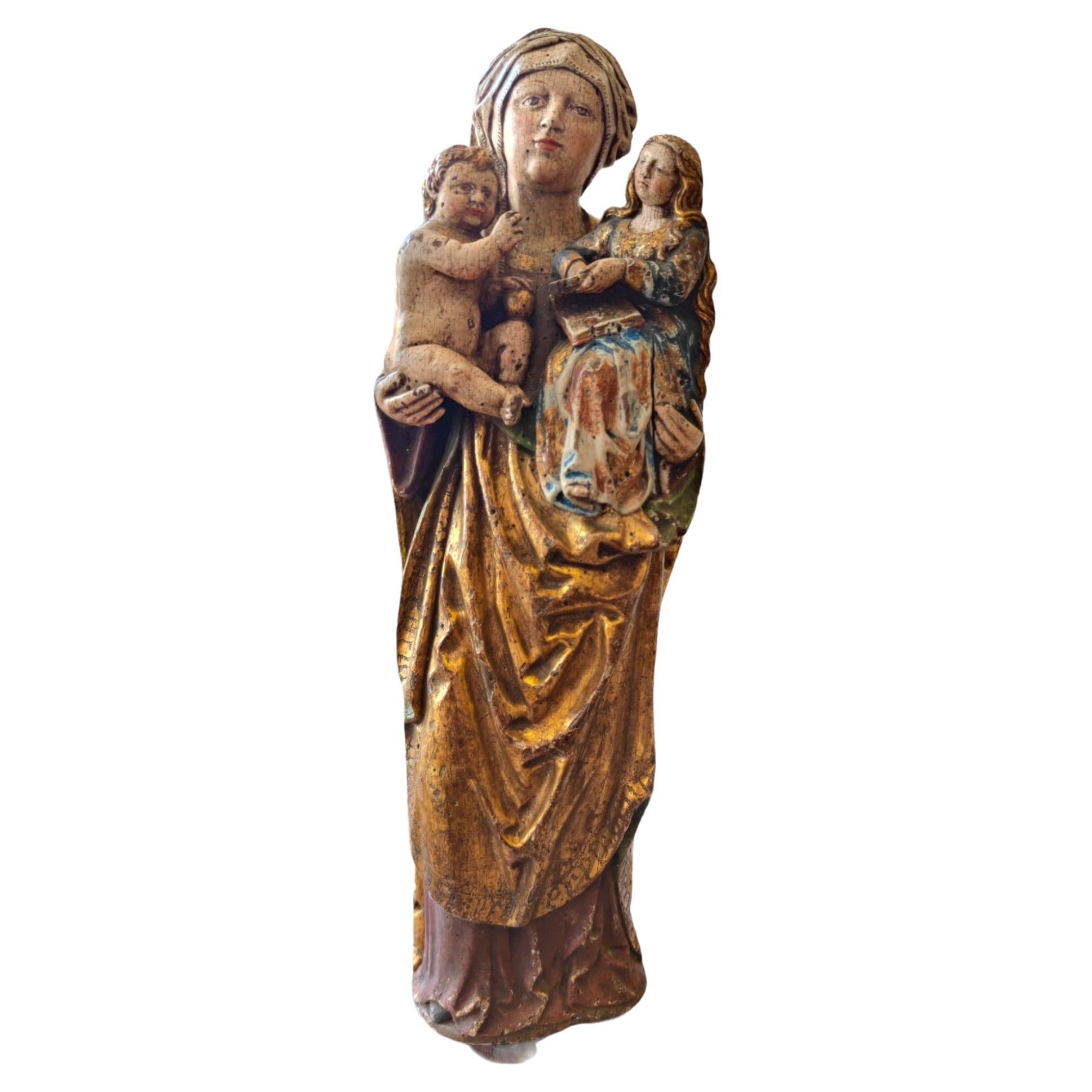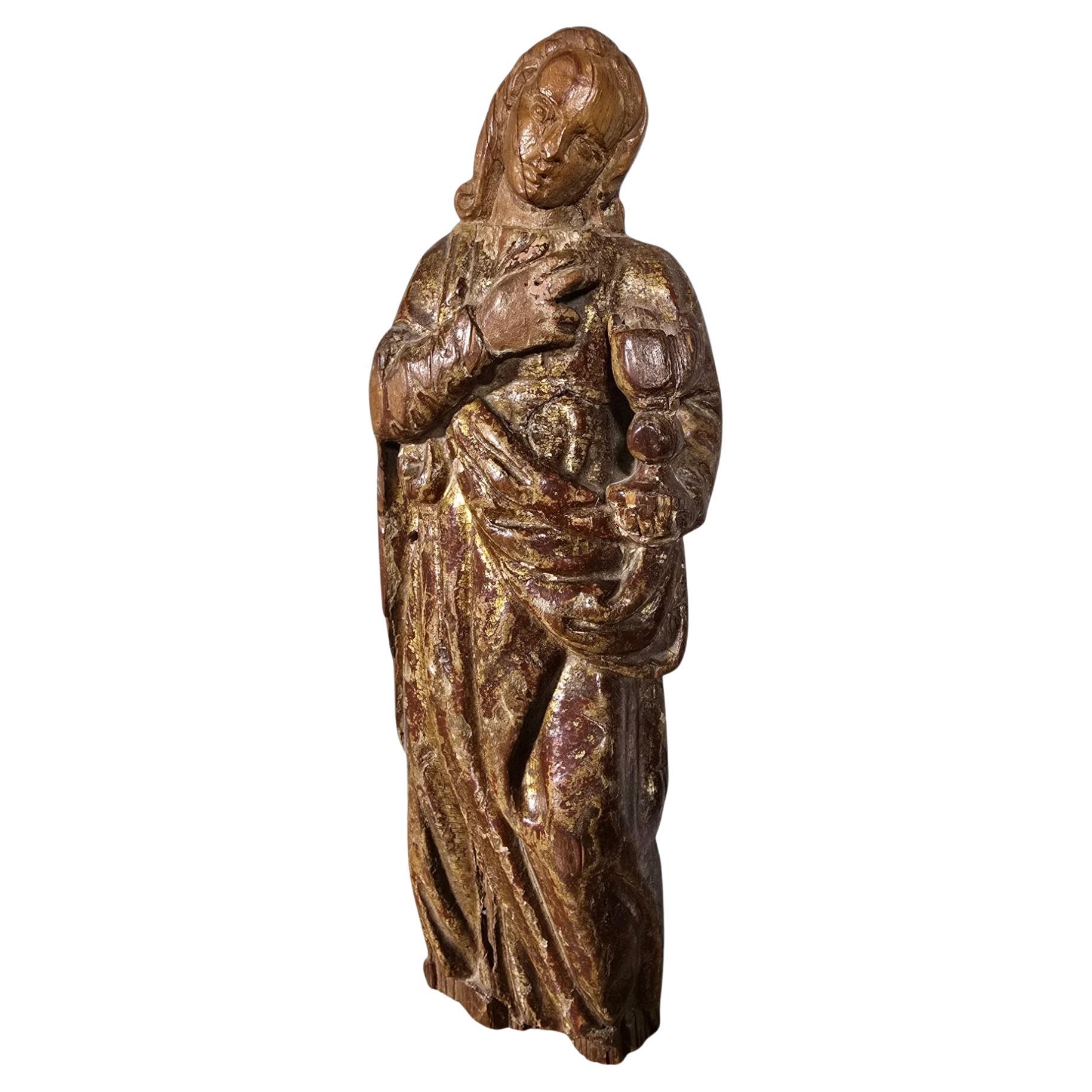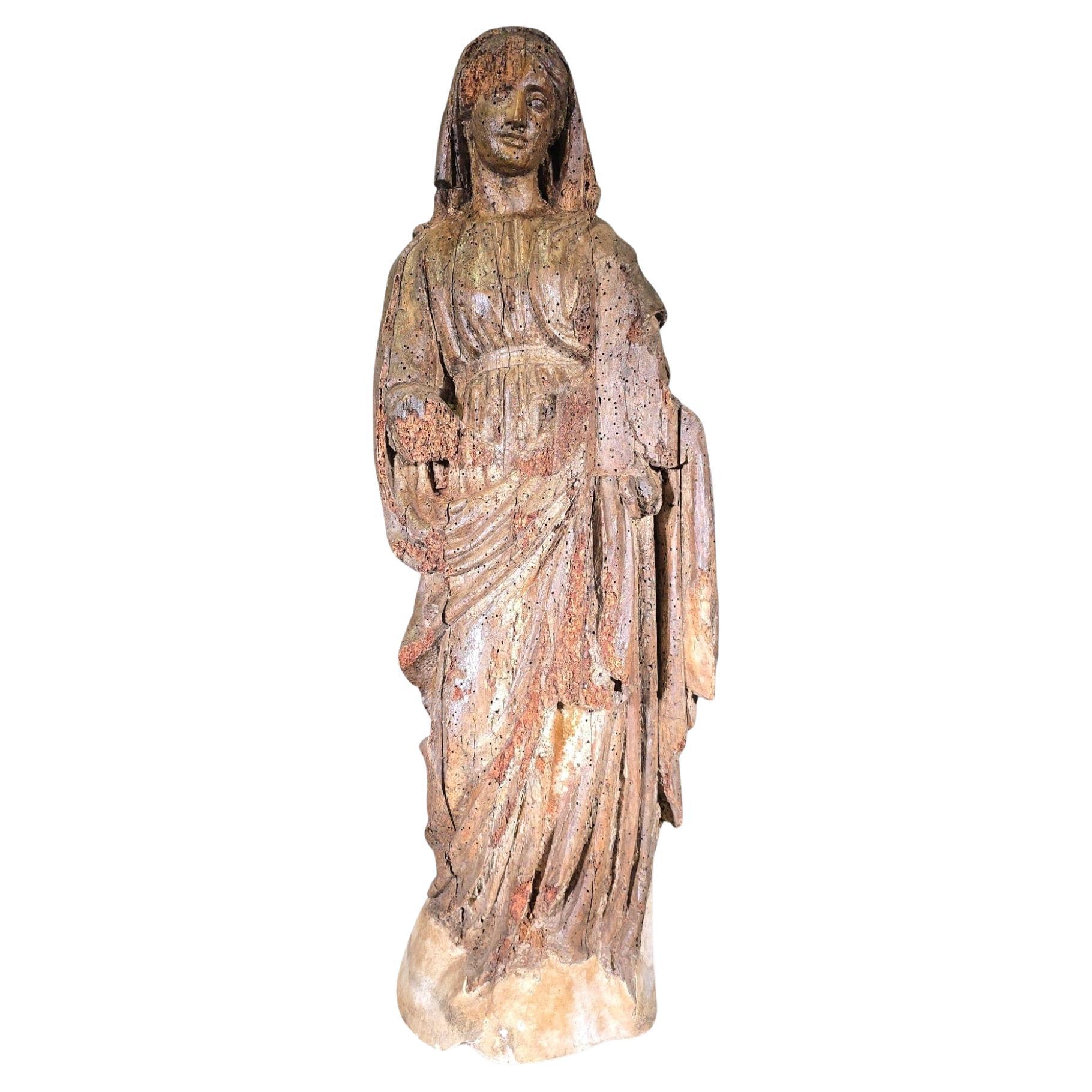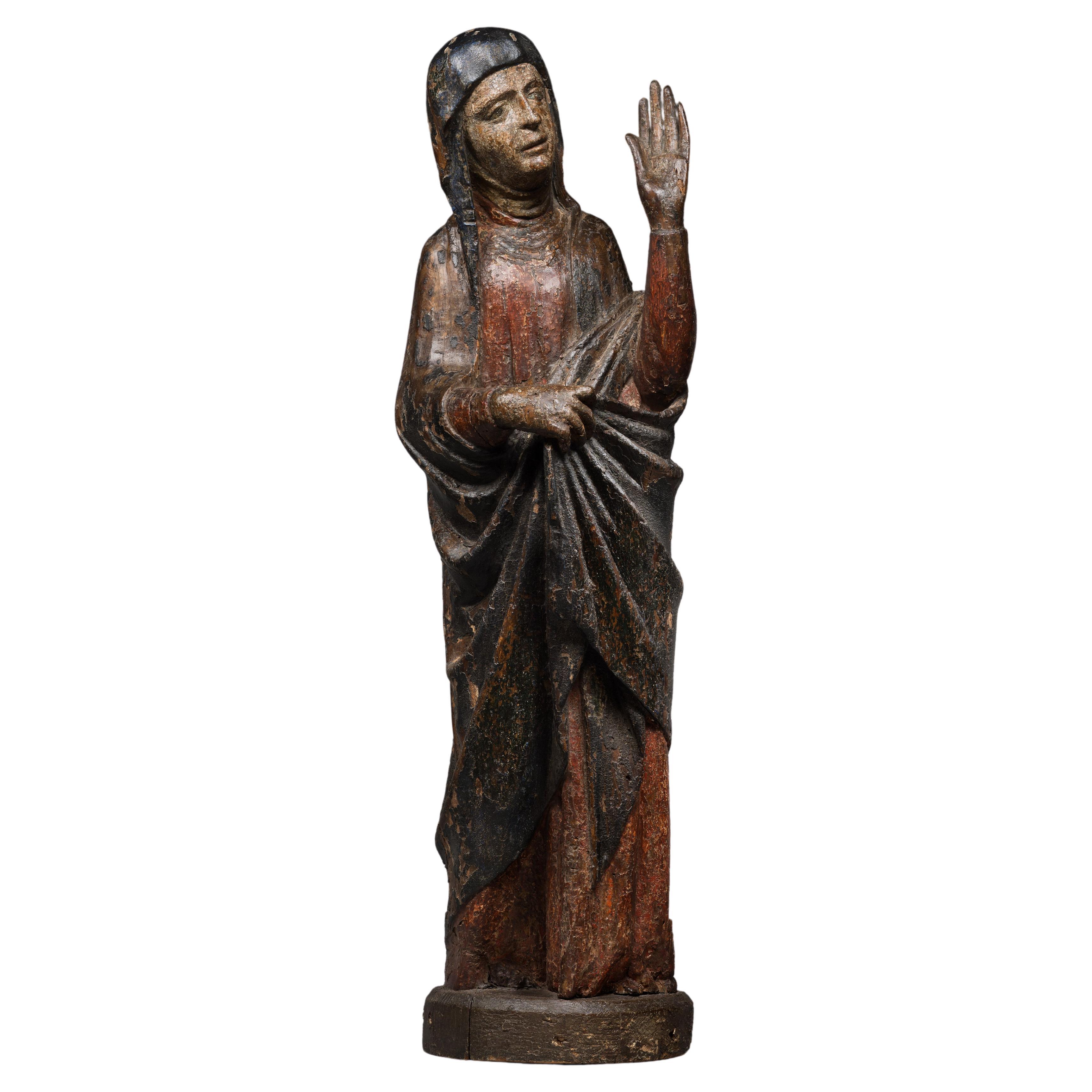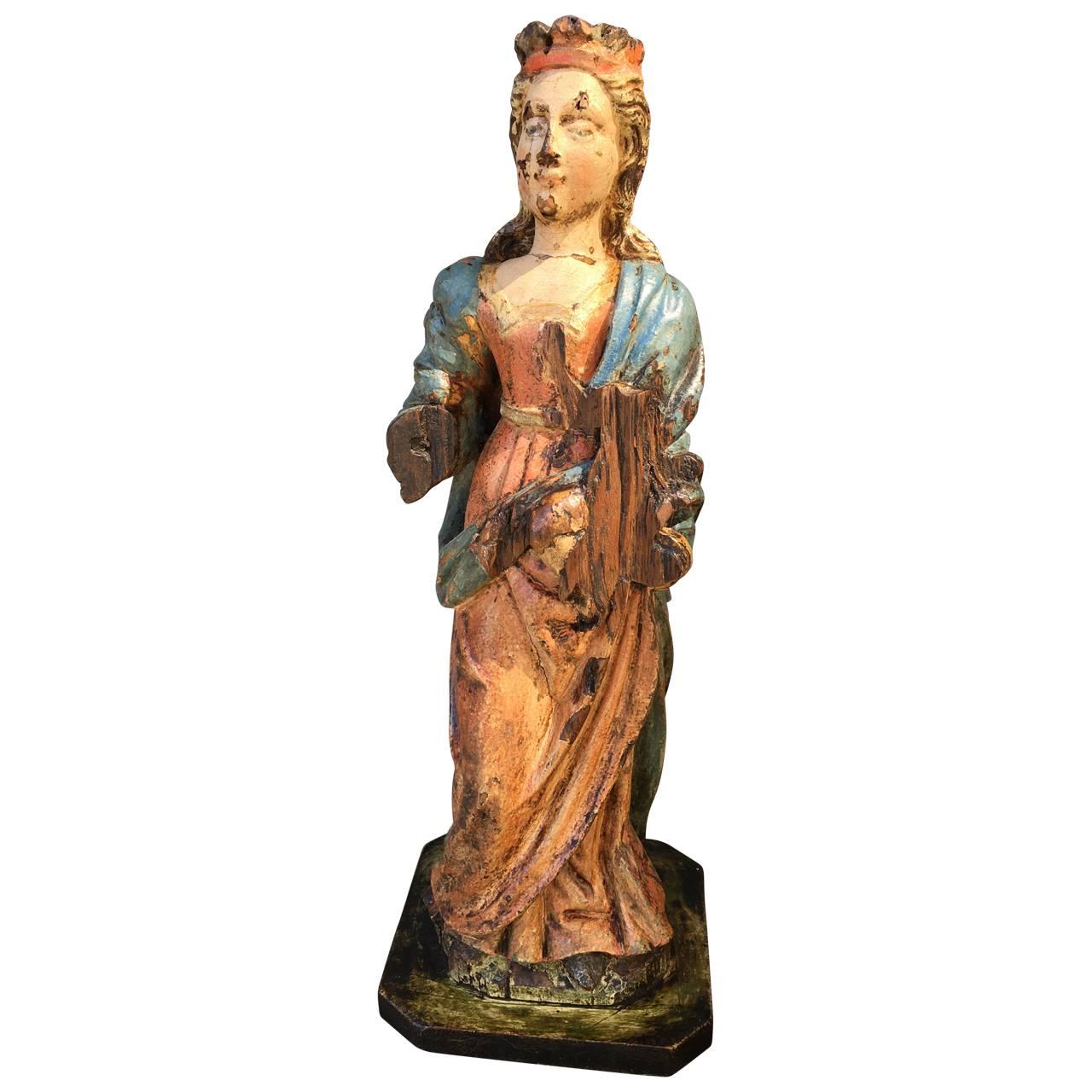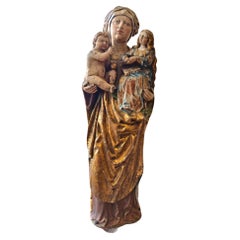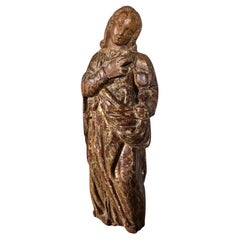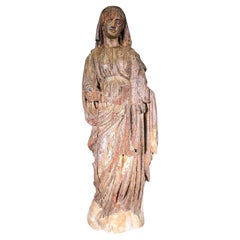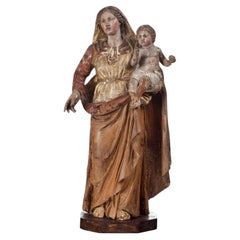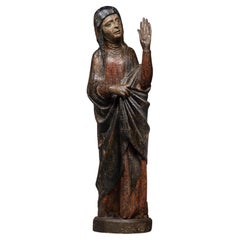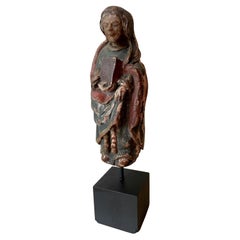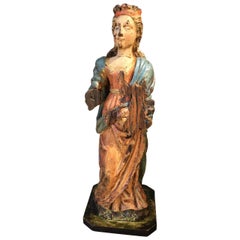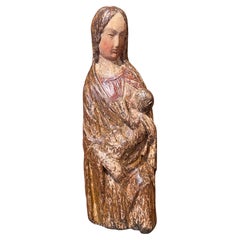Items Similar to Romanesque Sculpture of the Virgin – 15th Century
Want more images or videos?
Request additional images or videos from the seller
1 of 10
Romanesque Sculpture of the Virgin – 15th Century
$31,129.32
£23,159.90
€26,000
CA$43,369.52
A$47,202.47
CHF 24,780.87
MX$570,274.79
NOK 311,027.34
SEK 293,261.99
DKK 197,969.42
About the Item
"Romanesque Sculpture of the Virgin – 15th Century"
Period: 15th century
Romanesque
Technique: Carved and polychromed solid wood
Dimensions: 124 x 36 x 17 cm
Impressive Romanesque sculpture of the Virgin, carved in solid wood and retaining traces of its original polychromy. Dating from the 15th century, this devotional piece is distinguished by its hieratic appearance, characteristic of the Romanesque style, and by the sobriety of its forms, which convey an intense spirituality.
The sculpture depicts the Virgin in a frontal and rigid position, perhaps in an attitude of majesty, following the typical medieval iconography of religious sculptures of the period.
Conservation Condition: Good overall structure; it shows wear and defects typical of its age, which reinforce its authenticity and historical value.
An exceptional work due to its rarity, size and condition, it is ideal for collectors of sacred art or specialist museums.
- Dimensions:Height: 48.82 in (124 cm)Width: 14.18 in (36 cm)Depth: 6.7 in (17 cm)
- Style:Greco Roman (In the Style Of)
- Materials and Techniques:
- Place of Origin:
- Period:
- Date of Manufacture:1450
- Condition:Wear consistent with age and use. Minor losses.
- Seller Location:Madrid, ES
- Reference Number:1stDibs: LU5779245052702
About the Seller
4.8
Platinum Seller
Premium sellers with a 4.7+ rating and 24-hour response times
Established in 2005
1stDibs seller since 2021
376 sales on 1stDibs
Typical response time: <1 hour
- ShippingRetrieving quote...Shipping from: Madrid, Spain
- Return Policy
Authenticity Guarantee
In the unlikely event there’s an issue with an item’s authenticity, contact us within 1 year for a full refund. DetailsMoney-Back Guarantee
If your item is not as described, is damaged in transit, or does not arrive, contact us within 7 days for a full refund. Details24-Hour Cancellation
You have a 24-hour grace period in which to reconsider your purchase, with no questions asked.Vetted Professional Sellers
Our world-class sellers must adhere to strict standards for service and quality, maintaining the integrity of our listings.Price-Match Guarantee
If you find that a seller listed the same item for a lower price elsewhere, we’ll match it.Trusted Global Delivery
Our best-in-class carrier network provides specialized shipping options worldwide, including custom delivery.More From This Seller
View All15th Century Gothic Virgin
Located in Madrid, ES
15th century Gothic Virgin
Gothic Virgin of the 15th century Virgin in carved and polychrome wood of the 15th century. In its original state, muse...
Category
Antique 15th Century and Earlier Figurative Sculptures
Materials
Wood
$20,952
Large Sculpture of the Virgin Mary from the 16th Century Dimensions: 98x35x25 cm
Located in Madrid, ES
This majestic sculpture of the Virgin Mary, created in the 16 th century, is a unique piece of sacred art that stands out for its impressive detail and the beauty of its form. Crafte...
Category
Antique 16th Century Figurative Sculptures
Materials
Fruitwood
Large Sculpture of the Virgin Mary from the 16th Century Dimensions: 98x35x25 cm
Located in Madrid, ES
This majestic sculpture of the Virgin Mary, created in the 16 th century, is a unique piece of sacred art that stands out for its impressive detail and the beauty of its form. Crafte...
Category
Antique 16th Century Figurative Sculptures
Materials
Fruitwood
Wooden Madonna with Child Baroque Art Italy 17th Century with Export Certificate
Located in Madrid, ES
A Wooden Madonna with child Baroque art, Southern Italy, 17th century.
Measure: H: 71cm
Good condition for the time.
With Export Certificate to USA.
Category
Antique Early 17th Century Italian Baroque Figurative Sculptures
Materials
Wood
Wooden Madonna with Child Baroque Art Italy 17th Century with Export Certificate
Located in Madrid, ES
A Wooden Madonna with child Baroque art, Southern Italy, 17th century.
Measure: H: 71cm
Good condition for the time.
With Export Certificate to USA.
Category
Antique Early 17th Century Italian Baroque Figurative Sculptures
Materials
Wood
OUR LADY OF ASCENSION Portuguese sculpture, 17th Century H: 125cm
Located in Madrid, ES
OUR LADY OF ASCENSION
Portuguese sculpture, 17th Century
in polychrome wood.
Small defects and traces of treated xylophages.
Dim. Height: (total) 125 cm
Category
Antique 17th Century Portuguese Baroque Figurative Sculptures
Materials
Wood
You May Also Like
Virgin of Calvary
Located in Saint-Ouen, FR
VIRGIN OF CALVARY
ORIGIN : ITALY
PERIOD : SECOND HALF 13th CENTURY
Height : 75 cm
Length : 19 cm
Depth : 13 cm
Polychrome wood carved in the round
This rare sculpture of a Virgin of Calvary originally belonged to an ensemble depicting the Crucifixion. The Virgin would be accompanied by a sculpture of the apostle John, both flanking the Christ. Depictions of Joseph of Arimathea and Nicodemus could complete the ensemble.
The portrayal of the Descent from the Cross had to be a touching and moving scene for the viewer. Quite rare during the 10th and 11th centuries this particular scene of the Passion was very much in favour during the 12th century before other scenes took over in turn.
Mary is standing with her head slightly tilted to her right shoulder. In a gesture of intercession she raises her left hand – note the long and delicate fingers – towards the missing Christ while with her right hand she holds her cloak around her elbow. Those calm and restrained movements break with the hieratism of Romanesque sculpture...
Category
Antique 15th Century and Earlier Figurative Sculptures
Materials
Wood
$47,891
12th Century Rare Romanesque Wood Sculpture of the Virgin Mary
Located in Vero Beach, FL
12th century extremely rare romanesque wood sculpture of the Virgin Mary.
Magnificent wood hand carved sculpture of the Virgin Mary holding a book to her chest.
It is an extremely rare survivor of the 12th century. The style is European, possibly French or English. This statue is a testimony to beautiful religious art from about 1150. A truly rare Romanesque sculpture...
Category
Antique 15th Century and Earlier English Medieval Figurative Sculptures
Materials
Stone
$11,200 Sale Price
20% Off
Early 17th Century Sculpture
Located in Copenhagen, K
Amazing Baroque sculpture of a woman wearing a crown in original paint. Her hands are missing. Colors are untouched, recently cleaned off from a thick dark coating, I have images fro...
Category
Antique Early 17th Century French Baroque Figurative Sculptures
Materials
Oak
Rare Nursing Virgin from the 14th century
Located in Saint-Ouen, FR
RARE NURSING VIRGIN FROM THE 14TH CENTURY
ORIGIN : ITALY
PERIOD : 14TH CENTURY
Height : 60 cm
Width : 20,5 cm
Depth : 11 cm
Wood
Seated and in a very maternal position, Mary is wearing a red dress with a long, flowing cloak covering her narrow shoulders and falling down her body, with one side hugging her bust.
Her hair, half hidden under a veil, frames an oval face featuring a high forehead, a long and thin nose, a small mouth with thin lips and half-closed eyes.
Mary is carrying her son, the infant Jesus, who is wrapped in a cloak, in her lap. Jesus is being nursed by his mother, held by her left hand.
This remarkable depiction, imbued with such gentleness, is directly inspired by the iconographic theme of the Virgin and Child in Majesty. It breaks with the hieratic, impassive style of the models from the 12th and 13th centuries, adding a touch of realism. From Virgin Queen, Mary became Virgin Mother.
Linked to the development of the Marian cult, this type of representation, sometimes known as Virgo lactans, Virgin of Milk or Nurturing Virgin, remains extremely rare. This image of the Virgin Mary and the Infant Jesus is an extremely delicate representation of the intimate bond formed...
Category
Antique 15th Century and Earlier Italian Gothic Figurative Sculptures
Materials
Wood
17th French Century Iron Figure of The Virgin
Located in Stamford, CT
Wonderful 17th century French Baroque cast iron figure of the Virgin praying. Likely originally part of an outdoor shrine as it has been exposed to the ...
Category
Antique Early 17th Century French Baroque Religious Items
Materials
Iron
Important 14th Century Polychrome Limestone Virgin from Lorraine
Located in Saint-Ouen, FR
Provenance :
- Kunsthaus Heinrich Hahn, Frankfurt am Main, sale 16, June 17, 1930, lot 16.
- Sotheby's, Amsterdam, Feb. 26, 2006, lot 201.
HISTORIC
Located between Moselle valley and Meuse valley, framed by the Vosges Mountains on the south side and the duchy of Luxembourg on the north side, the duchy of Lorraine is the result of several partitions. It starts with the 9th century when the Carolingian empire is divided, with Lothar 1st inheriting Lotharingia. In 959 this territory was in turn divided in two; Lower and Upper Lotharingia, the latter being the forebear of the duchy of Lorraine. This duchy was under the rule of the Holy Roman Germanic Empire until 1736 when it was absorbed by the kingdom of France.
All along its history the duchy of Lorraine has found itself in the midst of many conflicts. Alliances and feuds marking European history were always particularly sensible in Lorraine where instability was frequent. Because of its geographic position the duchy of Lorraine was also an artistic crossroad.
Hence the duchy of Lorraine becomes from the 13th century onwards an important artistic centre where a particular type of Virgin and Child appears. According to professor J. A. Schmoll the characteristics of Lorraine sculpture burgeon around 1280-1300 in the Aube region. It presents “vigorous volumes, restrained movements, rare but solemn gestures and a strong interiorised and stern expression”. Those Virgins look similar with a wide forehead, a shield- or oval-shaped face, large neck, small lips and a cleft chin.
This model is particularly in favour during the 13th century because of the revival for Marial worship and for the theme of the Virgin and Child. It bears witness to a new religious sensibility with a more intimate vision of religious practice.
DESCRIPTION
The important 14th century Virgin we present to you is one of the most beautiful examples of sculptural art from Eastern France, with her fascinating distant gaze.
Her contrapposto posture is induced by the weight of the child she carries high on her left side. The child has a chubby face framed by blond hair with well defined curls and he wears a long red V-collared tunic from which emerge his feet. The fabric is animated by long folds. The position of the right foot turned to the back is a detail we can notice on several Virgins from Lorraine. He holds a bird that seems to be pecking his thumb.
“The bird /held by the child in his hands/ has been read as a reference to an episode from Christ’s childhood when he has moulded sparrows with clay before giving them life. It appears in the apocryphal gospel of Pseudo-Matthew (ch. 27) and later in the Quran (III, 43, v. 110). However the iconography seems to be more influenced by the concept of Redemption or of Eucharist, the bird symbolising the soul of the Christian about to be redeemed or revitalised.”
Mary wears a long dress with two rock crystal cabochons remaining from the original five. She is covered by a red cloak enriched with old-gold motifs draped as an apron falling in long pleats along her left hip. The relief treatment and the volume of the cloak developing a network of concentric pleats contrast with the the flat pleating of her dress. They nevertheless suggest the curve of her bent right leg.
She wears a floret crown securing a short thin veil carved in very low relief. From it emerges her blond curled hair characteristic of the 13th century. The large face with almond-shaped eyes, straight nose, small lips and cleft chin casts its gaze afar in a fashion typical of 13th century Virgins.
In her right hand she holds a lily flower. In a very refined manner the artist has carved a band on her right ring-finger.
In the back, carefully sculpted, spreads the minutely detailed short veil.
COMPARATIVE STUDIES
This sculpture of great quality presents obvious similarities with Virgins from Lorraine, designated by William Forsythe...
Category
Antique 15th Century and Earlier French Gothic Figurative Sculptures
Materials
Limestone
More Ways To Browse
15th Century Italian
Religious Sculptures
Polychrome Virgin
Roman Marble Fragment
Roman Porphyry
Rosenthal Porcelain Figure
Rousseau Bronze
Royal Dux Figurines
Sculpture Bronze Diane
Smoking Sculpture
Snake Dancer
Standing Buddhas
Stella Bronze
Stone Carved Faces
Stone Male Sculptures
Terracotta Clodion
Terracotta Fruit
Terracotta Warrior
